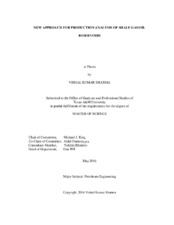| dc.description.abstract | Shale Gas/Oil reservoirs have emerged as an important reserve in global energy markets in the last decade. Oil and gas production from shales has been possible due to horizontal drilling and multiple-stage fracturing.
Shale has low permeability, in the range of nano-darcy’s. To increase flow from such reservoirs the only known solution is to increase the area for flow, which can be done by Hydraulic Fracturing. This gives an optimum solution for economically producing hydrocarbon from these reservoirs. It is very important to find a way to quantify reservoir and fracture permeability, and the extent of the hydraulic fractures that have been created.
In this research, the focus is on a method of analysis which can give information on the propagation of pressure waves as well as on the properties of the reservoir. These techniques gives us two approaches. In the first, the reservoir and fracture model is fixed and the pressure wave propagation and the reservoir performance is predicted. In the second approach, performance is measured and then inverted for the area of the propagating pressure wave. This interpretation technique does not involve any assumed model but is developed directly from production data.
The current research approach is based on the concept of the diffusive time of flight and drainage volumes. The diffusive time of flight is derived from the high frequency asymptotic limit of the diffusivity equation.
For the first approach, we have assumed different wave propagation geometries. Analytical solution for these geometries were validated with synthetic simulation case and by comparing it with other well testing equations.
The second approach is a novel method of interpretation of performance data in which we try to evaluate a model without using any pre-assumed geometry of the fracture or pressure wave propagation. This approach gives the new way to interpret field data and to compare the well performance based on the propagation area.
Our second approach for the analysis of the production data is more promising than other approach as the requirement for the predefined model was eliminated. | en |


